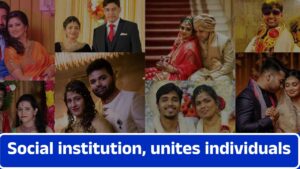Social institution, unites individuals in a formal partnership or marriage
1. Introduction
Matrimony, a vital social institution, unites individuals in a formal partnership or marriage. It holds immense cultural, emotional, and societal significance, evolving from traditional arrangements to modern and technology-driven approaches.

2. Types of Matrimony
- Traditional Matrimony: Family-arranged marriages were central in many cultures, emphasizing compatibility and family connections.
- Modern Matrimony: Includes love marriages and partnerships arising from mutual choice and emotional bonds.
- Online Matrimony: Revolutionized matchmaking, offering convenience and broad access through platforms like Shaadi.com and Bharat Matrimony.
3. Evolution of Matrimony
From ancient cultural practices to the incorporation of technology, matrimony has adapted to societal shifts. Globalization and changing norms now blend traditional values with contemporary expectations.
4. Online Matrimonial Platforms
- Offer advanced features like profile creation, filters (education, caste, religion), and privacy controls.
- Benefits include convenience, broader matchmaking options, and faster communication.
- Challenges include verifying profile authenticity and addressing privacy concerns.
5. Cultural and Regional Practices
- Indian matrimony emphasizes caste, community, and regional traditions.
- Global matrimony reflects diversity, with unique customs in Western, Eastern, and interfaith marriages.
6. Compatibility and Astrology
Astrology remains integral in some cultures for matchmaking, while psychological and personality tests gain traction in modern practices.
7. Preparing for Marriage
- Financial Planning: Joint finances and future security are key.
- Emotional Preparedness: Open communication, trust, and counseling strengthen bonds.
- Legal Aspects: Registration ensures rights and responsibilities are legally recognized.
8. Challenges in Matrimony
- Societal pressures often clash with individual preferences.
- Dowry and gender inequality continue to be major hurdles despite legal reforms.
- Empowering mutual respect and equal roles are pivotal for progress.
9. Matrimonial Trends in 2025
The rise of niche platforms, focus on personality-based compatibility, and inclusion of LGBTQ+ communities signal the evolution of matrimony toward inclusivity and technology-driven solutions.
10. Conclusion
The future of matrimony lies in harmonizing tradition with innovation, fostering relationships built on compatibility, mutual respect, and shared values.
This summary condenses the main points of the article while preserving its essence. Would you like more details on any section
